#nanoq
Note
hi lizz! i’m currently taking an elective course on the bibles usage in art throughout history and am writing a piece on art ushering in religious experiences/ art being used to fill the vacuum left by religion in the modern day. i was wondering if you had any particular favourite pieces that invoke these feelings in yourself? i’ve also suffered a loss in my family this week and amas has been very comforting in this time so i wanted to thank you <3
Hi! Oof, what a question! I've been trying to consider what this might specifically mean for me- the idea of something that would fill a religious vacuum. I think I have a couple ideas, but I don't know if they are specifically what you want.
When I think of what you are describing, I think of moments of wonder and being overwhelmed and sometimes feeling a little horror, a little confusion. I think of nature and man made objects sitting with each other in uneasy ways, of history and time collapsing in on themselves.
I think of Jan Fabre's 2002 work Hall of Mirrors, which was installed in the Royal Palace of Brussels. I have a lot of gripes with Fabre's practice as a whole, but there is something undoubtedly spectacular about this work and the fact that these beetle wing casings will probably long outlive the palace they've been placed in. They will retain their color and luster after the building has crumbled to dust.

I think of Olafur Eliasson's Ice Watch and Mark Wilson and Bryndis Snaebjornsdottir's Nanoq: Flat Out and Bluesome, because I find the idea of encountering evidence of a disappearing environment like this to be unsettling and otherworldly and frightening and therefore holy. In Ice Watch, Eliasson installs icebergs into cities, where they will melt before our eyes. In Nanoq, all the taxidermied polar bears in The United Kingdom were placed in one room- an ark of anxiety as to why and how these bears arrived in these places and how this may soon be the only way we can see them.


I also think of Dario Robleto's work- most of it, to be honest- because it attempts to reach through time to explore experiences of love and death and tries to see how those sensations might be made physical. Robleto's work deserves a longer explanation than I currently have time for, but he is certainly worth sitting with for quite awhile.


You might also look at the work of Guadalupe Maravilla if you're thinking of direct mystical experiences, or someone like Adrian Villar Rojas whose work has to do a lot with the displacement of objects in time. The Theater of Disappearance is very dear to me and was, indeed, a religious experience to walk through.
Somewhere in my house I have a copy of Art and Religion in the 21st Century by Aaron Rosen- I remember enjoying its approach to the subject, if you aren't familiar with that book already.
I'm very sorry for your loss, and happy that AMAS has been a comfort.
22 notes
·
View notes
Text
Painting, fun :>
I really like how my army of little plastic men has turned out. Here are my faves.
Veteran Captain Inunnguaq (means cute or small human).

Currently unnamed Veteran Captain.

Unnamed Librarian.

Unnamed Veteran.
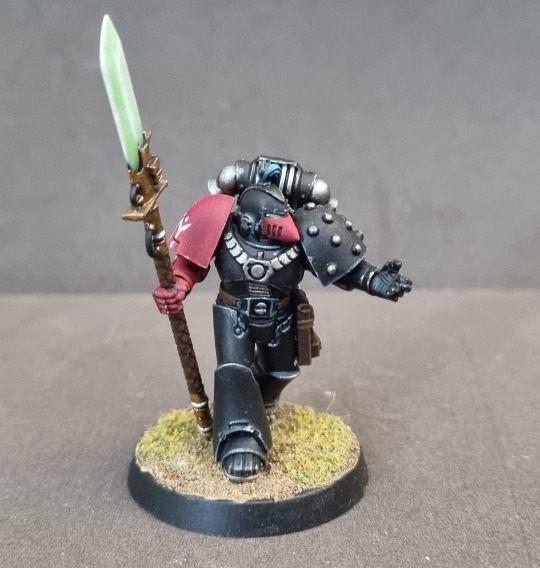
Veteran Captain Tulugaq(Raven).
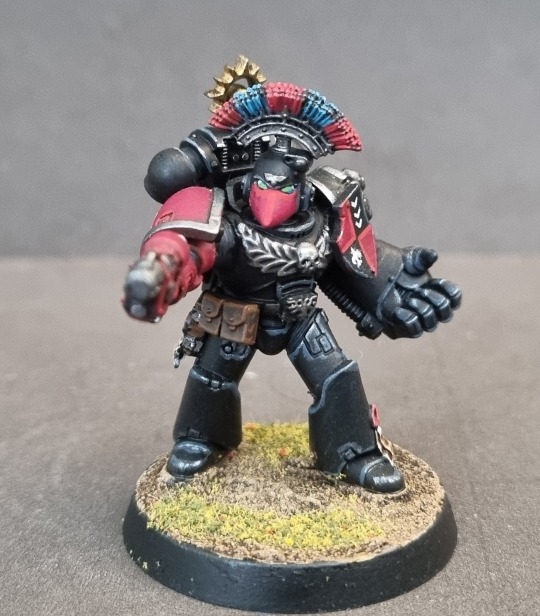
The Assault Squad Veteran that has the sasquatch pose.

Terminator Librarian.

Chapter Master Tornaq(Great spirit).

The Deathwatch returnee Chief Apothecary.

And Venerable Brother Veteran Nanoq(Polar bear).

Based my entire space marine army this friday/saturday. in total 86 marines I think I went for a light earthy color with some summer-ish flock on.
I was struggling for a long time with giving them a backstory.
Just had a chapter name(Abyssal Seals) and the idea that they were friends with seals.
Until around Christmas last year, I remembered that near my hometown in Greenland, there's a bay called the Monk Bay. So I based them on Greenland Inuit culture. Each marine has markings based off of Inuit tatoos to denote squad and veteran status. Each marine is psychically bonded with a seal at their initiation. The planets populace refer to them as piniartorsuit(the great hunters). And other little things that just makes them my guys.
#wh40kpaint#wh40k#painting warhammer#space marines#adeptus astartes#Abyssal Seals#warhammercommunity
48 notes
·
View notes
Photo
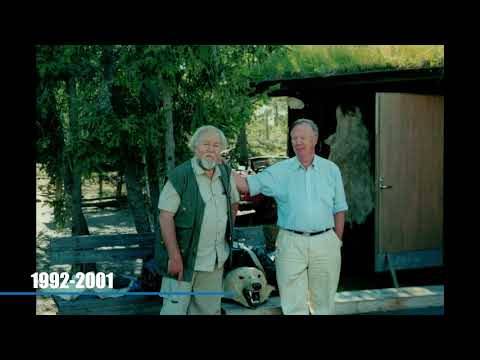
Nanoq Arctic Museum || Nanoq's 30 year journey! - Travel Online Tips In the summer of 1991, Nanoq opened its doors for the first time. This year we turn 30 years old, Videos #Videos #travel #love #photooftheday #nature #photography #instagood #travelgram #travelphotography #travelblog #travel #travelgram #travelphotography #wanderlust #instatravel #travelling #travel #travelgram #photooftheday #travelphotography #trip #instatravel #foodandtravel #foodie #foodporn #food #foodblogger #foodphotography #foodies #foodiesofinstagram #travel #foodpornshare #sogood #travelonlinetips #MarkWeins #holiday #vacation #staycation
0 notes
Photo



Arctic Museum Nanoq, Taken 2011
The bear cub on the second photo was raised by the man on the photograph since he found the bear mother dead (not his fault) and chose to save the it.
2 notes
·
View notes
Video
youtube
Kalaallisut (West) Greenlandic
Nanook - "Nanook" Polar bear/The Master of Bears
Nannup angalaarfia
tusaajuk qupparpalunnera
aqqutigisaa ingerlavigisaa nungullarpoq
Nanook, Nanook tammartajaarpoq
The trail of the polar bear
Hear it cracking
Its path is slowly disintergrating
Nanook, Nanook is straying
L I R I Q Q I S U
#Nanook#Kalaallisut#Greenlandic#Greenlandic song#Greenland#nipilersorneq#language#nanoq#polar bear#language music#world music#music#Kalaallit Nunaat
2 notes
·
View notes
Photo







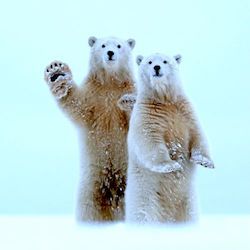

character aesthetics - ourana cobalt nanoq, lieutenant of the white fang ?
ghost bear wanders, always alone;
[queen] of the north,
dispensing death from [her] traveling throne.
- edith pattou
#rwby original character#rwby#ourana nanoq#sosy aesthetics#mmmm she is a Juisy Charakter#and i love her very much
5 notes
·
View notes
Text
Greenlandic Text Lesson 3
So far: Text lesson #1 and Text Lesson #2
This text lesson looks at a short article that recently appeared on Greenlandic national broadcaster KNR (Kalaallit Nunaata Radioa – “Greenland’s Radio”).
Qeqertarsuarmi nanorsiortut
februaarip 02-at 2017
Qeqertarsuarmi ippassaq unnukkut nal. 23 missaani nanorsiortoqalerpoq.
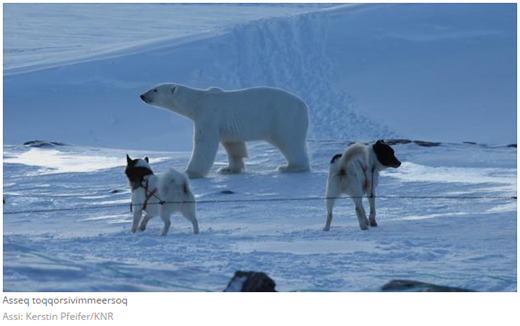
Nanoq Qeqertarsuup illoqarfiata iluani ippassaq unnukkut takuneqarpoq. Kingorna qamuteralassortunit arlalinnit ujaarineqarpoq pisarineqaranili.
Piniarnermik nakkutilliisup Per Nukaaraq Hansenip Sermitsiaq.AG-mut ilisimatitsissutigaa illoqarfiup ungasinngisaani sikumi nannuttoqarsimasoq, pisarineqartorlu tassaassagunartoq illoqarfimmi ippassaq unnukkut takuneqartoq.
Aamma oqaluttuarpoq nannup pisarinissaanut akuersissummik tunniussisoqarsimasoq.
Video KNR.gl-ip nassiussarsiarisimasaa ataani takuuk:
Link
Vocabulary
qeqertaq - island
-:suaq - large
Qeqertarsuaq - town in West Greenland, on the island of the same name, formerly called Disko Island.
-mi – locative case (in), singular form
nanoq - (polar) bear
Interesting fact: the Latin name for the brown bear is ursus arctos, which you would think ought to be the Latin name for the polar bear. However ursus and arctos are simply the Latin and Greek words, respectively, for “bear”. So the Arctic region is named after the bear(s), rather than the other way round. The polar bear is ursus maritimus or “sea bear”, which kind of makes sense.
-:sior- - to hunt for, to catch the scent of
-toq - one who (does verb) (absolute form), plural form -tut. Can also mean “(the fact) that someone (does verb)”
februaari - February
-(i)p - ending for the singular relative form. Can function like a genitive form (showing the possessor) but also marks the subject in a transitive sentence. Here februarip = “of February". Note that the object "owned” by the relative form must also be declined to reflect its possessor.
2-at = aappaat - their second one (absolute form of aappaq: second, other, with a plural possessor) Note aappaq also appeared in Text Lesson 1 in its other meaning of spouse, partner
So februarip aappaat means “the second of February”, but where is the plural possessor, if February is singular? The reason is that the phrase is a short form of februarip ulluisa aappaat, where ulluisa is the relative case (“genitive”) form of ullut, but with a singular possessor (February). So the whole phrase means “of-February of-its-days their-second-one”. However the ulluisa is presumably redundant here and can be dropped without affecting the meaning, but is reflected in the declination of aappaat.
ippassaq - yesterday
unnukkut - (last) evening, prosecutive (vialis) case (-kkut, meaning through, by, along with) of unnuk: evening
nal. - short for nalunaaqutaq: hour, watch. Here corresponds roughly to “o'clock” (albeit using the 24 hour clock)
missaani - about, approximately
-qar- - have, exist, there is
-ler- - start, be about to, be in process of
nanorsiortoqalerpoq - “there started to be people hunting bears”, i.e. “a bear hunt got underway”
asseq – photo. assi – his or her own photo
toqqorpaa – he hides it, he stores it
-si- - intransitive marker, makes a transitive verb into an intransitive one
-vik,-(-r)fik – place where…
-mit – ablative case, “from”. Derived from this is a verbal form -meerpoq to be from, and from this -meersoq: one which is from. So asseq toqqorsivimmeersoq: photo which is from the stores, i.e. archive photo
-:suup - dependent form of -:suaq
illoqarfik - town, settlement. Formed of illu (house, cognate with Inuit “igloo”), -qar- have, exist, and -fik place where…
ilua – “its inside”, the inside of something.With -ni (in): iluani – “in the inside of” illoqarfiup iluani – in the town. Qeqertarsuup illoqarfiata iluani – in the town of Qeqertarsuaq. As with the ulluisa example above, the middle noun has to be in the relative case to show “ownership” of iluani, but is also “owned” by Qeqertarsuaq, and so the relative case form showing a third party (singular) possessor -ata is used.
takuvaa – he sees it
-neqar- - creates passive verb form
Giving takuneqarpoq – it was seen
kingorna – later
qamutit – (dog) sled
-ralak - suffix meaning poor, dear old, bad, nasty.
Add the two together and you have qamuteralak snow scooter. I’m not quite sure how this word came about in this way! Maybe a true Greenlander sees a snow scooter as a poor alternative to a proper dog-powered sledge…
-:sor- - various meanings, but here meaning “using…”
-toq/-soq – one who (verbs)
-nit – ablative (by, from) case marker, plural form. Here meaning “by”, denoting the agent for the passive verb takuneqarpoq.
arlallit – several, ablative form is arlalinnit
ujaari- - to be out looking for…
pisaq – a catch (result of hunting)
pisaraa – formed of pisaq + -gaa/-raa to have something as a catch. Add -neqar- (passive) and the negative contemporative mood -nani/-rani (while not verb-ing), giving pisarineqarani “while not being caught”
-li – but. Note that it comes at the end of the word, although in English we would place it before. Compare –lu and below
piniar- – to go hunting
-neq – forms verbal nouns, the act of doing (verb)
-mik – instrumental case. Roughly translatable as “more specifically…”, providing additional information about a verb or noun (Jensimik ateqarpoq: “he has a name, more specifically Jens” = “he is called Jens”), and can also be translated in English as an indefinite object if used with an intransitive verb.
nakkuppaa – stare at (object), from which nakkutigaa – to keep an eye on something, the intransitive form of which is nakkutilliivoq. Hence nakkutilliisoq one who oversees, supervisor, attendant, officer
nuka – younger sibling of the same sex (a boy’s little brother, a girl’s little sister)
-araq – diminutive ending, little
-mut – allative case (towards), singular form
ilisimavaa – to know (object).
-ti*- - causative affix, to have something happen, to make something happen. So ilisimatippaa – to inform him/her (of something) (i.e. to “cause to know”). With ending-ssut cause of, means to we have ilisimatitsissut – notification, report. And with ending –gaa “to have something as one’s…”, we have ilisimatitsissutigaa meaning roughly “he had [the following phrase] as his report: …”
ungasippoq – to be far
-nngi- - negative affix, not
-saq – normally forms a passive noun ending, one which is verb-ed, but here the meaning of ungasinngisaq (not far, close by) doesn’t appear to be passive, although maybe it serves to connect the word to its possessor illoqarfiup, giving illoqarfiup ungasinngisaani – “in the proximity of the town, close up to the town”
siku – ice
-mi – locative case (in, on), singular form
nannuppoq – to bring down a bear. It’s interesting to note that the verb “to kill” an animal is often a derived form of the animal’s name. Another example is tuttuppoq to kill a reindeer from tuttu: reindeer
From the above comes nannuttoq – one who shoots a bear or “that [someone] shot a bear”, with -qar-to exist and -sima- perfective aspect (“have done”) and -soq/-toq, here meaning “(the fact) that…”. Together: nannuttoqarsimasoq “that there has been the shooting of a bear”, i.e. “that a bear has been shot”
pisaraa (see above) + -neqar- (passive) and –toq “the one that…” to give pisarineqartoq “the one which was caught”.
-lu – and. Note that, like –li but, this affix comes at the end of the word which is being “added”, although in English we would place it before.
tassa – it is, namely, such
-u- - to be (a+u > aa in accordance with standard Greenlandic spelling and pronunciation rules)
-ssa- - future tense marker
-gunar- - apparently
aamma - also
oqaluttuar- - tell
nannup – relative case form of nanoq. Note the irregular doubling of the middle “n”.
pisarinissaanut – broken down as pisari- (to have as a catch, see above) + neq (verbal noun, appears as ni when the -r- falls away) + -ssa- (future tense marker) + -a (its, referring back to nannup: the bear’s) + -nut (allative case (to)). “To its (future) catching …”
akueraa – he/she is in agreement with him/her. With -si- (intransitive marker, see above) and –ssut (cause of, the means to) we have akuersissut: permission. Here in the instrumental case –mik which can be translated as an indefinite object of the intransitive verb tunniussi- below.
tunniuppaa – he/she hands it over (to someone). Here with -si- (intransitive) + -soq (“the fact that”) + qarsimasoq (as in nannuttoqarsimasoq above).
-ip – form of relative case after a consonant (here, the website name KNR.gl)
nassiuppaa – he/she sends it.
-:saq – passive noun ending. nassiussaq – a thing which is sent, a dispatch
-:siaq – something obtained. Here with –raa (-ri-) (have something as one’s…) + -sima- (perfective) + -:saq (passive noun ending) + -a (its) we have the formidable nassiussarsiarisimasaa “which has been had by it [KNR.gl] as an obtained dispatch” or more naturally “which KNR.gl has been sent by somebody”
ataa – under (it). Here with locative –ni, giving ataani “located under”
takuuk – imperative form of takuvaa he/she sees it, with single object, giving “(please) see (it)”
Translation
Qeqertarsuarmi nanorsiortut
Bear Hunt in Qeqertarsuaq
februaarip 02-at 2017
2 February 2017
Qeqertarsuarmi ippassaq unnukkut nal. 23 missaani nanorsiortoqalerpoq.
A bear hunt took place yesterday evening in Qeqertarsuaq at around 11pm.
Nanoq Qeqertarsuup illoqarfiata iluani ippassaq unnukkut takuneqarpoq. Kingorna qamuteralassortunit arlalinnit ujaarineqarpoq pisarineqaranili.
A polar bear was seen yesterday evening in the town of Qeqertarsuaq. It was then searched for by several people on snow scooters but without being caught.
Piniarnermik nakkutilliisup Per Nukaaraq Hansenip Sermitsiaq.AG-mut ilisimatitsissutigaa illoqarfiup ungasinngisaani sikumi nannuttoqarsimasoq, pisarineqartorlu tassaassagunartoq illoqarfimmi ippassaq unnukkut takuneqartoq.
Hunt officer, Per Nukaaraq Hansen, informed Sermitsiaq.AG [a newspaper] that a bear had been shot on the ice close by the town, and this was presumably the one that had been seen yesterday evening in town.
Aamma oqaluttuarpoq nannup pisarinissaanut akuersissummik tunniussisoqarsimasoq.
He also said that a licence had been issued to shoot the bear.
Video KNR.gl-ip nassiussarsiarisimasaa ataani takuuk:
See below the video that has been passed to KNR.gl.
As ever, if there are any questions on the above, I would be happy to try and answer. Any corrections by native speakers are also very welcome!
@tulunnguaq
31 notes
·
View notes
Text
Nanoqgender


Nanoqgender: a gender that is fluffy, soft, icy, and snowy. It is connected to big polar bears, winter, and the slipperiness of ice and snow
Etymology: Greenlandic, “nanoq” meaning “polar bear”

8 notes
·
View notes
Text

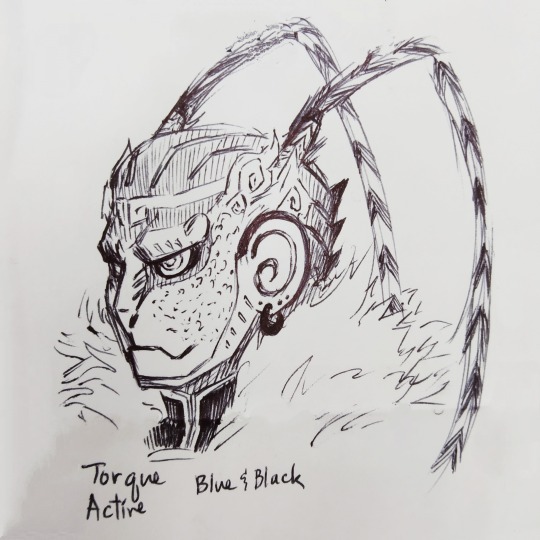
Rin and Ojiro from R-batch-19
They are Chinese myth themed and are named after gems.

We don't know Class-B's seat numbers so I'm just gonna go put Rin in 6. Both of them match in a lot of ways anyway.
This batch, Torque was allowed to postpone his nanoQ transmutation till the age of 20 and had two kids with Crystal(placeholder name for Hagakure.)
#ojiro mashirao#rin hiryu#bnha cyberpunk au#bnha#mha#ojirin#mjdraws#mjsketch#should I even post at what age the ojiros die?
51 notes
·
View notes
Text

Look at my commissioned bOYYYYYY
he is my DnD character please hit me up if you’d be willing to have this Druid Ranger arctic lad.
His name is Nanoq
2 notes
·
View notes
Photo
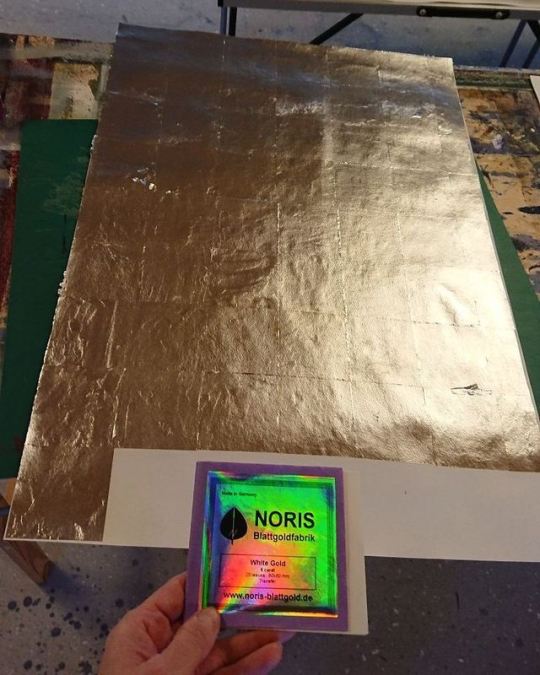
Process from idea to final design... Hand gilded, hand drawn sketch, hand cut stencil, hand painted motif of greenlandic Tuukkaq and Ulo #oneoutoften #anniversary #celebration #whitegold #gilded #greenland #inspiration #artwork #handmade #handpainted #handstencilled #handgilded #contemporary #craft #revitalized #craftsmanship #tuukkaq #ulo #polarbear #nanoq #madeindenmark #danishdesign (her: Tapetværkstedet)
#contemporary#anniversary#craft#handstencilled#polarbear#handgilded#nanoq#madeindenmark#handmade#revitalized#danishdesign#ulo#oneoutoften#craftsmanship#handpainted#inspiration#celebration#greenland#tuukkaq#gilded#whitegold#artwork
0 notes
Note
If you're still looking for name ideas, then may I suggest; Ivalu or Nanoq, they're Greenlandic names tho (and nanoq apparently means polar bear)
Tbh Nanoq would be soo cute but my family already has a cat named Nano :(
1 note
·
View note
Photo
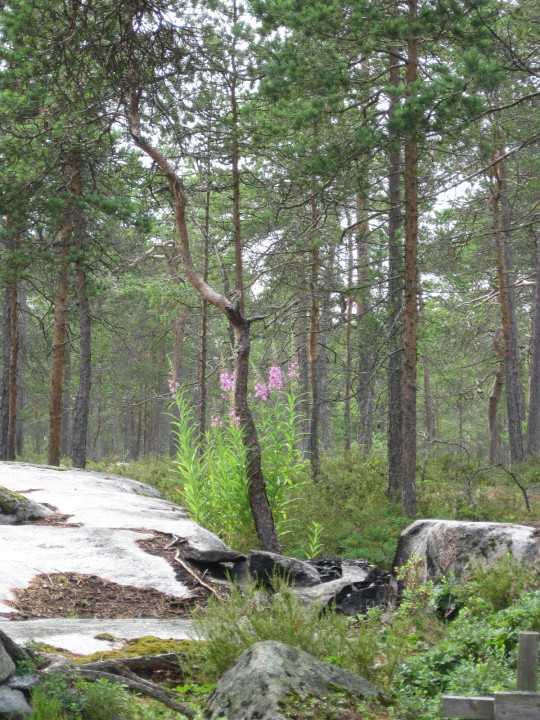
Nature - Arctic Museum Nanoq, Taken 2011
0 notes
Text
Márci-sztik-us
Szia!
Igen hamar elröppent két hét. Legalább is számomra úgy tűnik,hogy így történt.
A bejegyzés címe annak szól, hogy mióta itt vagyok kissé olyan érzésem van mintha körülöttem forogna a világ. Az emberek érdeklődnek a történésekről, hogylétem felől, és megjegyzik, hogy nem látták az “új bejegyzést”. Igyekeztem sok képpel gazdagítani a bejegyzés beltartalmi értékét a vizuálisan több stimulálást igénylőknek kedvezve. Még videót is fogsz találni ha végig olvasod, nézed amit írtam, beágyaztam ide. No neki is látnék akkor.
Legutóbb éppen az On Arrival Training-re készültem Kokkolába. Nos, ezen is túl vagyok már és az élményeknek is hagytam időt ülepedni. Ugyan ezt a folyamatot valamennyire lassította a résztvevők valamelyike által létrehozott Whatsapp csoportban történő üzenetváltások frekventáltsága és tartalma. Röviden fogalmazva szeretet túltengésről és egymásba kapaszkodási késztetések áradásáról tudok beszámolni. Ennyi szívecskés emoji ikont én egy helyen még nem láttam. Ugyanakkor bizonyos szempontból megható is a többiek ez a fajta lelkesedése.
Na de kik is ők. Egy csoportképpel próbálom közelebb hozni őket most hozzád.
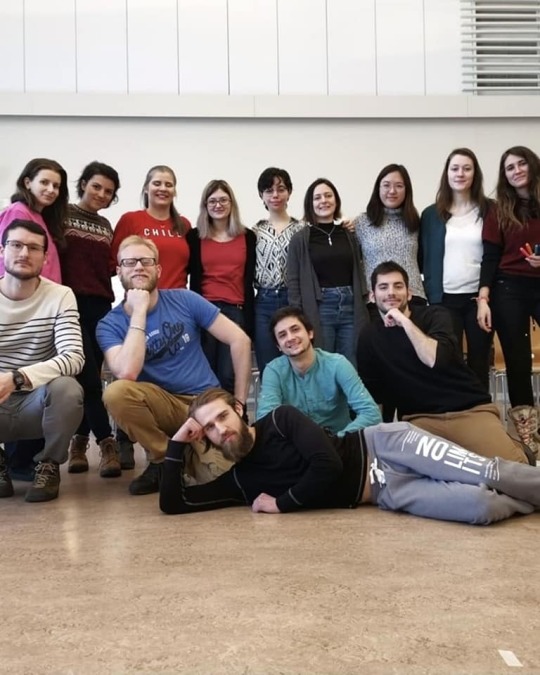
Bal fentről haladva. Sasha Észtországból, Cristell Franciaországból, Élise szintén Franciaországból, Eli Romániából, Maéva Franciaországból, Noemi Olaszországból, Sabine Ausztriából, Valentine Belgiumból, Célia Franciaországból, jómagam, Simone Franciaországból, Marko Szerbiából, Leonidas Görögországból, és végül de nem utolsó sorban kifeküdve az utolsó francia Matthieu. Nem árulok el nagy titkot ha azt írom; kisebb többségben voltak a franciák.
Ez némileg befolyásolta a dinamikákat, mivel adódott számos olyan helyzet amikor ez a hét ember (a belga Valentine is franciául beszélt) az anyanyelvét használta, amit többen nem értettünk. Szerencsére volt olyan közöttük, aki szorgalmazta az angol nyelv előtérbe helyezését.
A tréning része volt egy bingóra hasonlító játék, aminek a lényege abban rejlett, hogy párokban lehetett feladatokat teljesíteni, pontokat gyűjtve. A záró napon pedig ezeket a pontokat ajándékokra válthattuk. A feladatok között volt például a hóangyalok készítése. Erre látható tökéletes példa alább, amikor Célia és én próbálkoztunk a fagyott hóban finn stílusban teljesíteni a “kihívást” az egyik reggelen.

Aztán volt még: 2 méteres hófal építése, a főépület kétszeri körbefutása, 10 perces edzés, rap szám írása, reggeli és vacsora privátban egy választott résztvevővel vagy trénerrel, egy téli történet írása, puzzle készítése, 10 embert magában foglaló ölelés, finn nyelven való megszólítása valakinek, hóember építés, versírás, festés.
Úgy indultam neki a játéknak, hogy minden egyes elemet teljesítek, de az idő előre haladtával egyre kevésbé éreztem ennek a szükségességét, mivel elég fárasztóak voltak a napok, és örültünk amikor nem kellett különösebben összpontosítani valamire.
Az ismeretségeket és az élményeket leszámítva nem éreztem különösebben hasznosnak a tréninget, de láttunk szép dolgokat és a többiek nevében is beszélve jól éreztük magunkat. Mert, hogy voltak szabadidős tevékenységek is. Mint például a sauna workshop, ami kevésbé fennkölten fogalmazva kötetlen beszélgetés volt a szaunában. Vagy az lékhorgászat, hótalpas séta, szabadulós szoba, kirándulás a Nanoq múzeumba.


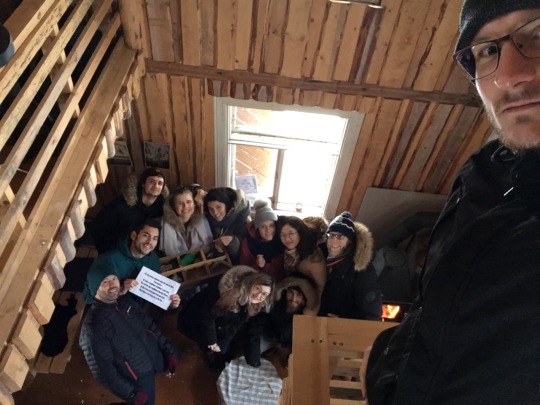
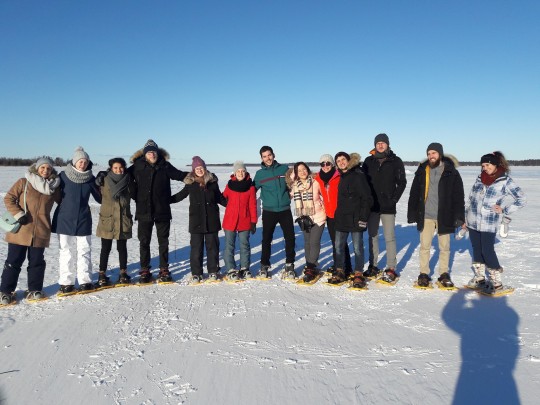
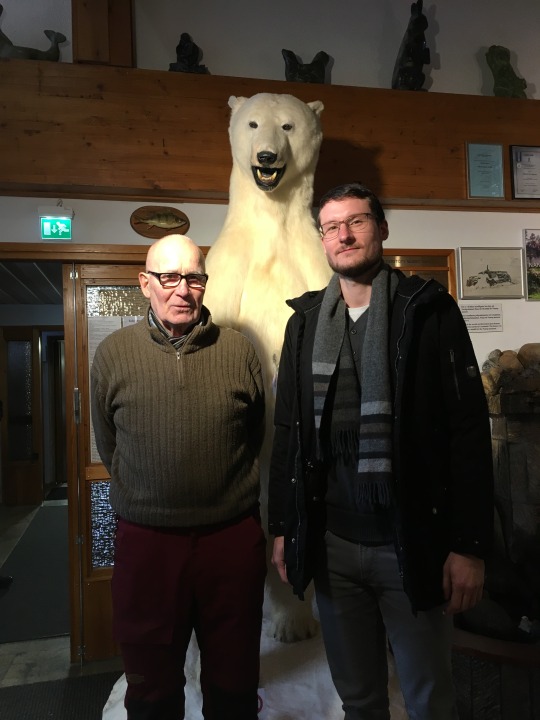
A képen látható úriember 7 alkalommal járt Grönlandon különféle expedíciókon. Rövid ideig élt is ott. Különösen kellemes élmény volt beszélgetni vele. Elképesztően szerényen mesélt kalandozásairól és a múzeumról, amit javarészt ő épített. Rengeteg kiállított tárgy azért lehetett a múzeumban, mert az évtizedekkel korábban szerzett barátai érdemesnek tartották a munkáját arra, hogy támogassák az erőfeszítéseit, aminek középpontjában a sarkköri életforma bemutatása áll.
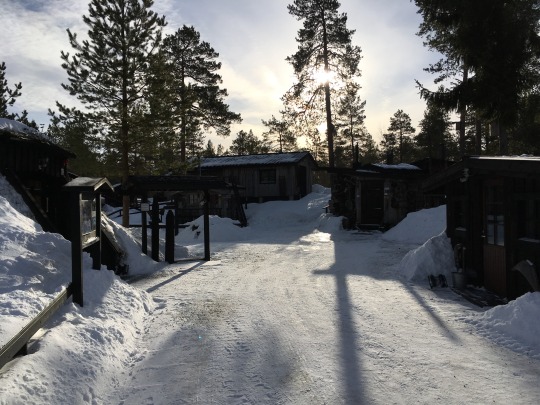
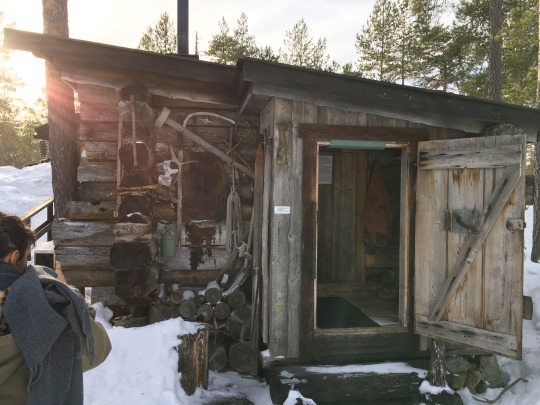

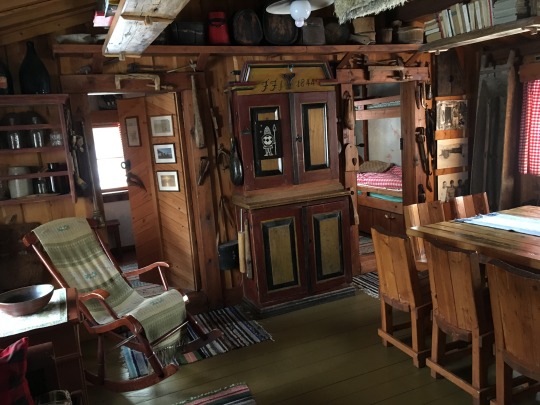
A kép jobb sarkában látható asztal 80 évet töltött a tengerben, egy elsüllyed hajó áldozataként. A felszínre emelést követően adományozta valaki a múzeumnak. A házikó érdekessége, hogy elemekre szedve árulták, volt is olyan ember, aki megvette volna tűzifának való, de szerencsére emberünk időben megmentette az utókor számára ezt a kellemes hangulatú faházat, ami olyan állapotban volt, hogy szívesen beköltöztem volna.
Május közepe táján várható majd egy második, úgynevezett Midterm Training is, ami Helsinkiben lesz. Ezt megelőzően viszont az emberek intenzíven tervezgetik egymás mielőbbi meglátogatását. Mert van aki a Svédországgal határos részen önkénteskedik, többen Lappföldön vannak, de akad olyan is aki egy nemzeti park közepén található nevezzük szabadidőközpontban szorgoskodik. Aztán vannak a nagyvárosiak Helsinkiben, Turkuban, Tamperében. Szóval lehetőségek szép számmal vannak, ha az ember látogatni szeretne. Engem egyelőre nem ragadott magával ez a hullám. Illetve azt hiszem szeretném is elkerülni lehetőség szerint egymás “körbe nyalogatását”. Talán ha “lecseng” ez a nagy érdeklődés akkor én is elmegyek ide-oda.
Ki kell emelnem az ellátás minőségét, amiben részesültünk. Az elszállásolásunk úgynevezett cottige-okban, azaz kisebb faházakban történt. Két fő per szoba. Két fürdővel, közösségi térrel. Kellemes környezetnek nevezném.
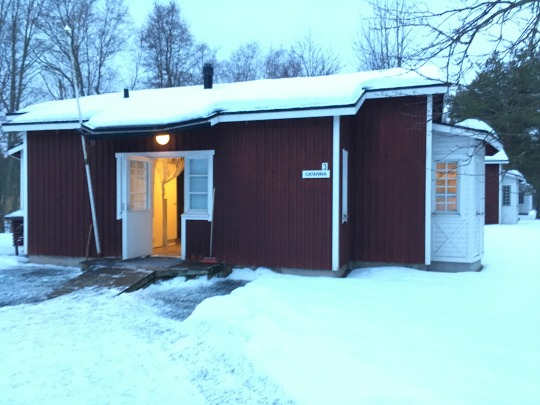

Ami az étkezéseket illeti mondhatnám kitettek magukért a konyhán. A vegán ételek ízletesek és változatosak voltak (a reggelit leszámítva, mert végig zabkását ettem eper lekvárral). A finn szokásokat szemléltetendő bemutatnám az étkezések időzítését. A reggeli nekünk fél 9-től volt. Az ebéd délben, a vacsora 18 órakor. Mivel a szálláshelyünkön, a Villa Elba központban van a gyerekeknek amolyan erdei iskola szerű program, így láthattuk mikor eszik egy igazi helyi. Az ebédre volt olyan aki 11 óra előtt megérkezett. A vacsorára pedig nem mindenki várt fél 5 utánig. Itt az esti éhséget megelőzendő bevezették az evening snack-et, más néven az esti nassolást. Ez nálunk a klasszikus vacsora megtestesítője otthon. És persze a kávészünetek szépen feltöltik a nap különböző idősávjait. Az evening snack-et leszámítva meglepően korábban vannak itt az étkezések. A napok előre haladtával már azt éreztük, hogy folyamatosan eszünk, de azért véletlenül sem hagytuk volna ki egyik étkezést sem. Megfigyelésem szerint társaim eszméletlen mennyiségű édességet tömtek magukba. Vegán opció nem mindig volt, így nekem könnyű volt távol tartani magamat a cukor hegyektől.
Néhány kép a a Kokkolában töltött időről.

Tea szünet. A brit akcentus gyakorlásának ideje.
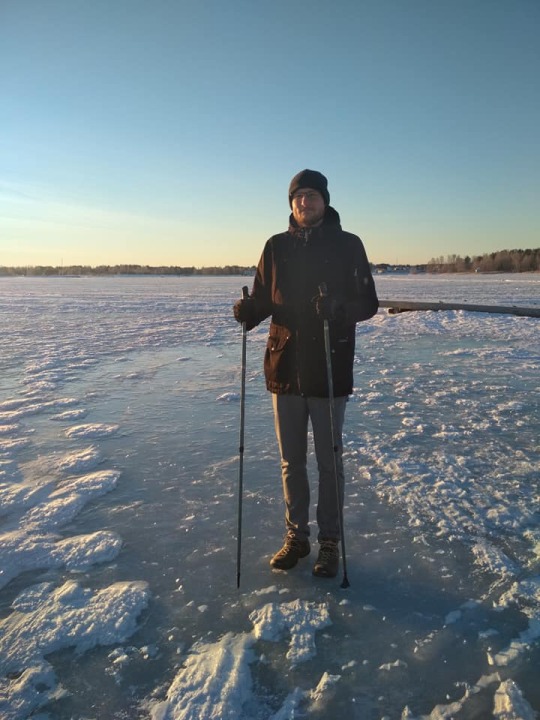
Bingo kihívás. 10 perces edzés. A választott mozgásforma a helyszínhez hűen nordic walking. A tengeren.
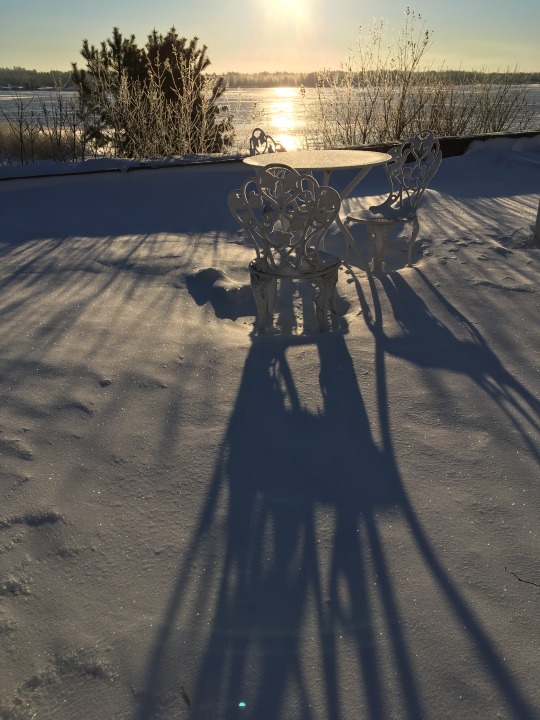
Ha nem lett volna mínusz 11 fok itt reggeliztem volna.
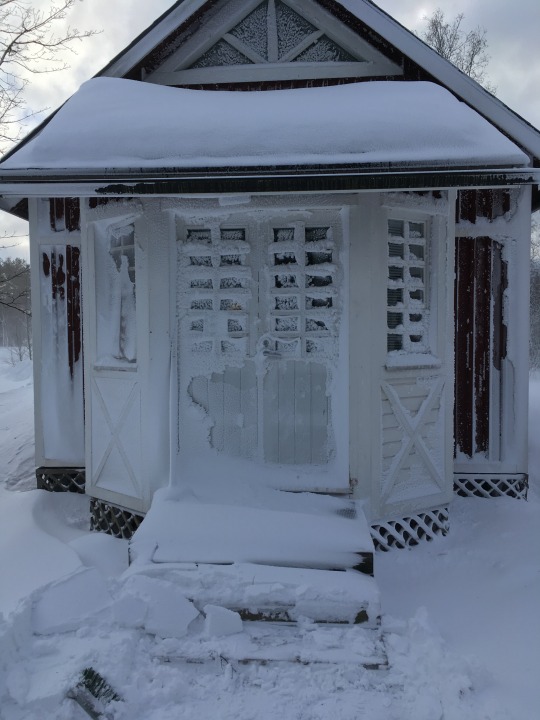
Hóvihar után. Előtt. Után. Ki tudja. Hóvihar bármikor jöhet errefelé.
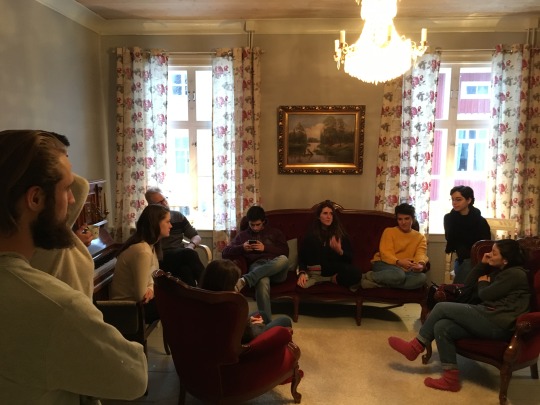
Meghitt pillanat a kokkolai tengerész kapitány XIX. században épült házában.
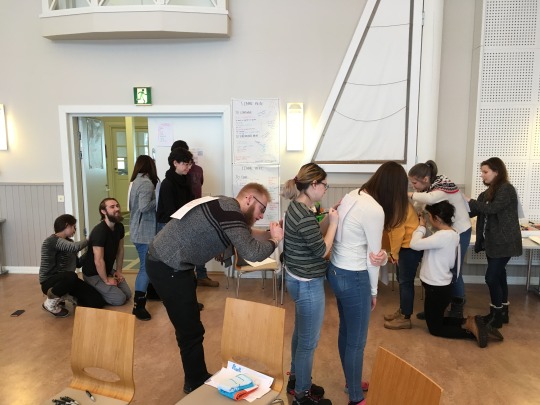
Az önkéntes “evolúciója”. Utolsó napi visszajelzések.
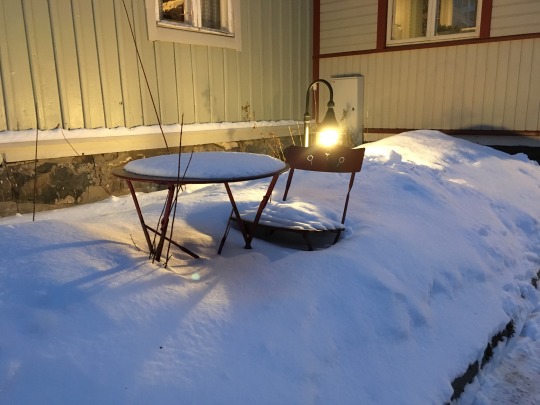
Jó étvágyat!


A képen a megváltozott halmazállapotú tenger látható. A jég több mint 35 cm vastag volt, ami személygépjárműveket is elbír. Így nem volt annyira meglepő kerék nyomokat látni a jégen, hóban. A jégen vezetés szabályai, mint megtudtam: biztonsági öv bekapcsolása nélkül, ablakot legalább résnyire lenyitva, hogy szükséghelyzetben legyen esélyed menekülni.

Kis napfelkelte utáni pillanat egy hűvös reggelen.
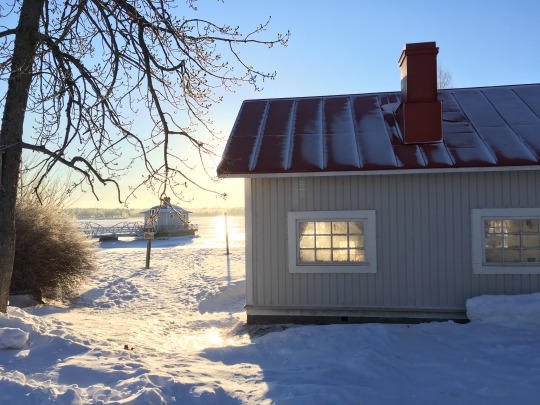
Elől játszó ház gyerekeknek, hátul szauna a tengeren (jó idő esetén használható).
youtube
youtube
youtube
youtube
Az esték nagy részén már kellően fáradtak voltunk ahhoz, hogy időben lefeküdjünk. Általában az öreg villában töltöttük a lefekvés előtti időt zenét hallgatva, Uno-t játszva és beszélgetve. Voltak olyan elszántak is, akik ilyenkor még próbáltak pontokat gyűjteni a Bingo-hoz és rajzoltak, fogalmaztak, miegymás.
A vonatút igen drága volt egyébként. Oda-vissza 114 Euró. Nem is meglepő, hogy több embertől hallottam mennyivel költséghatékonyabb az országon kívül utazni. Például itt ezen a héten síszünet volt. Múlt héten a déli részén az országnak, jövőhéten pedig a Lappföldön és környékén. Azért nincsen egy időben a szünet, hogy ne legyenek zsúfoltak a sípályák. Ugyanakkor ezzel a lehetőséggel nem tudom arányaiban mennyien élnek. A Kokkolából visszafelé vezető út egy szakaszán egy beszédes finn egyetemista srác ült mellettem, aki szintén megerősítette mennyire népszerű ilyenkor inkább ellátogatni inkább például egy európai nagyvárosba. Ő már kétszer volt Budapesten. Vele kapcsolatosan meglepő volt az előzetes információimat megcáfolandó a közvetlensége. Egészen személyes dolgokat is megosztott magáról a mérnöknek tanuló fiú. Kellemes társaságom volt az úton. A vonatok egyébként tiszták, gyorsak (mentünk 200km/h-val is) és kényelmesek voltak. Néhány érdekesség. Állítható magasságú fejtámasz az üléseken, amit én igen hasznosnak találtam. Kuka helyett szemetes zacskók az ülések mellett. Tehát ha használtam akkor magam kidobhattam a vonatról leszállva. Külön kocsi amiben házi kedvencet lehet szállítani. Sok lábhely, gondolva az átlag magasság felettiekre, akikből szerintem átlagosan itt több van mint hazánkban.
A tréning idején láttam az első igazán túlsúlyos embert. Az utolsó estén egy all you can eat helyre mentünk a csapattal. A vendéglátóipari egység higiéniai helyzete hagyott némi kívánni valót maga után, de látva ahogyan egyes gyerekek viselkedtek egyben nem is volt annyira meglepő a kosz. Volt vegán opció pizzából és desszertből is, ami kellemes meglepetés volt számomra. Rajtam kívül Matthieu, az egyik francia srác követte még ezt az étrendet. A túlsúlyos emberekre visszatérve egy kétgyermekes család sokkolt engem a jelenlétével a szemben elhelyezkedő asztalnál. Olyan egészségi állapotban lehettek (bár az emberi test elképesztően strapabíró), hogy megfordult a fejemben; mindjárt lefordul anyuka vagy apuka a székről két fűszeres csirkeszárny elfogyasztása között. Szerencsére ez nem történt meg. Az elhízás egyébként tapasztalatom szerint nem jellemző olyan arányban errefelé, mint otthon. Észrevételeim egyike az elfogyasztott saláta és zöldségek nagyobb mennyisége az általam ismert hazai viszonyokhoz hasonlítva. Itt szinten minden főétkezés részét képezi a saláta valamelyik variációja, és ezt az emberek eszik is. Az eddigi, nem itthon elfogyasztott ebédjeim során azt láttam, hogy sok helyen svédasztalos rendszerben működik a “kiszolgálás”. Az ember kifizeti azt a 10-12 Eurót, amibe átlagosan kerül egy ebéd, majd megy és szed magának a kínálatból. Ebben a kínálatban ott van a saláta, többféle párolt zöldség, magvak. Szinte minden alkalommal esznek itt az emberek egy kis kenyeret vajjal. Lehet választani az ízlésnek megfelelő pékárut (az egészen sötét színű, rágósabb állagú teljes kiőrlésű kenyértől a kalácsszerűen puháig és fehérig), és enni a főétel előtt, után, közben. A másik tétel, ami itt igen népszerű az a tej. Számomra indokolatlannak tűnő étel-ital társításként hat, amikor valaki a mi frankfurti levesünkhöz hasonlító ételhez hideg tejecskét kortyolgat. De hát erről szól a kultúr-sokk, mint azt a tréning egyik moduljában megtudtam. Az eltérésekről, amik meglepik, megrökönyítik és elgondolkodtatják az embert (már ha párhuzamot von az új és az általa jól ismert hazai között.
A trénereink, Kati, Marita és David említésre méltóan kedvesek, segítőkészek és energikusak voltak, amiért láthatóan mindenki hála teli tekintettel nézett rájuk.
Ezen a héten nem váltottam meg a világot azt hiszem. Mivel a síszünet ideje alatt nem voltak edzések, így feladataim jellege a megszokottól eltérő formát öltött. Egy edzőtáborba cseppentem, ami szerdától péntekig tartott. Tizenéves fiúk voltak a résztvevők, akik szombaton fontos (a magasabb osztályba való feljutásukról döntő) meccset játszottak. Én az étkeztetésükben segítettem, valamint az utáni való elpakolásban és takarításban. Meglehetősen trehányak voltak meg kell hagyni. Szerda este a csapattal tartottam a helyi uszodába, ahol átadtam magamat a szaunázásnak és a jakuzzinak. Számomra szemkikerekítő módon a zuhanyzók és a szauna használata kizárólag csupaszon megengedett. Én ezt csak a távozás előtti felöltözéskor realizáltam, amikor elolvastam az ajtóra ragasztott egyetlen angol szöveget tartalmazó matricát. Ekkor nyert értelmet az a sok kérdő tekintet amivel találkoztam. Történt mindez annak ellenére, hogy befelé menet megkérdeztem az egyik játékost (aki mert megszólalni angolul), hogy van-e esetleg olyan szokás vagy szabály amire érdemes figyelnem. A válasz természetesen a nem volt, de hát ki gondolta volna különleges szabálynak a no fürdőgatya előírást a helyiek közül. Mára megtanultam; mezítelennek lenni a fürdő zuhanyzójában, szaunába NEM OPCIONÁLIS. Tehát legközelebb én is megmutatom az uszoda férfi közönségének a micsodámat, hogy “egálra mentsem” a dolgot és jóvátegyem hibámat.
Csütörtökön pedig a bowlingozás okozta örömökben merültem el. A velem egy pályára osztott fiúkat gond nélkül magam mögé utasítottam, azonban amikor teljesítményemmel igyekeztem volna kiemelkedni az egész csapat közül akkor jelezték; indulunk haza. Jajjjj.
A héten kaptam újabb digitalizálni való anyagokat Jaritól. Könyveket, füzeteket, képeket. Ezekkel szorgoskodtam részben, de maradt bőven az elkövetkezendő hetekre is.
A következő egy hónap egy előre egyeztetett forgatókönyv szerint zajlik majd. Tovább erőltetjük a tematikus open gym alkalmakat, illetve több edzésen veszek majd részt. Azt, hogy mekkora hatásfokkal még nem tudni. Elméletileg amennyiben nem, vagy nem jól működik ez a rendszer akkor újra gondoljuk. A hónap végét színesíti majd a Helsinkibe látogatásunk, ahol egy alumni rendezvényen veszünk majd részt, ahol fiatal, első osztályú játékosok találkozhatnak egykori kiválóságokkal, edzőkkel és kérdezhetnek tőlük, illetve megoszthatják karrierjükkel, vagy mással kapcsolatos dilemmáikat segítséget, tanácsokat és bíztatást remélve. Egyelőre nem tudom mi lesz a dolgom, talán képeket készíteni.
A héten volt itt egy kisebb ünnep. Zászlók felhúzva. A Kalevala évfordulójára emlékezett a nép. Mivel egy kis településen élek így nem tudom mekkora ünnepségek voltak országszerte, de itt a zászlókon kívül én semmivel sem találkoztam. Rosszul mondom. Kacsákkal is. Napozó-fürdővő kacsa haddal.
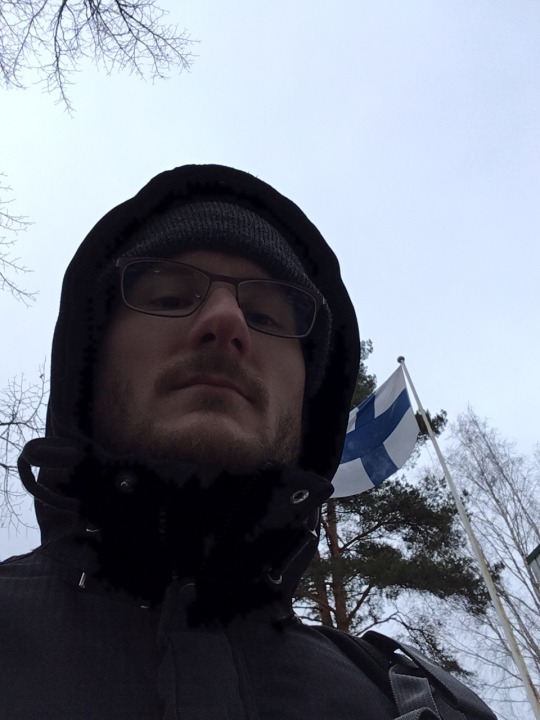

Azt hiszem megosztottam amit lehetett és eszembe is jutott.
A finn érdekességek, furcsaságok és miegymás rovatból biztosan sok mindent kihagytam, de hát ez van. Sajnos nem írok fel mindent amiből puskázhatnék ilyenkor. Na, majd csak kisegít a memóriám a következő bejegyzésnél. Annál a bejegyzésnél, aminek időzítése nem tervezett. Egyszer csak spontán elérhetővé válik majd. ;)
Addig is szépet s jót!
1 note
·
View note
Photo
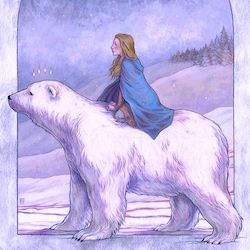








ship aesthetics - maturana (matu shaos/ourana cobalt nanoq)
“east of the sun and west of the moon.” as unfathomable as the words were, i realized i must figure them out, reason it through. for i would go to this impossible land that lay east of the sun and west of the moon. [...] all that mattered was to make things right. and i would do whatever it took, journey to wherever i must, to reach that goal.
- edith pattou
3 notes
·
View notes
Text
Greenlandic lesson 12
So far: lesson 1, lesson 2, lesson 3, lesson 4, lesson 5, lesson 6, lesson 7, lesson 8, lesson 9, lesson 10, lesson 11 and Greenlandic stress
Learn this course’s words with this memrise course.
Text lessons by @tulunnguaq: All his posts.
What you will learn: weak geminating stems #1, transitive verbs #1
Weak geminating stems #1
In lesson 7, I first introduced you to weak and strong nouns. In lesson 9, we spoke about slightly irregular weak nouns and in lesson 10, we dealt with possessive nouns. But many weak nouns (some strong nouns, too, though) also have another feature, they geminate the last consonant of the stem when certain endings are applied to it. Gemination is the doubling of a consonant so that it is pronounced twice as long. The tricky part here is not only to remember when gemination happens but also how the consonant changes, because a doubled consonant can change its pronunciation completely. You’ve already encountered that in lesson 3, when we spoke about verb stems and their assimilation with the ending -vu- like in sinippoq (coming from sinik+vu+q, where /k+v/ assimilate to /vv/ but I told you there that /vv/ cannot exist as a geminated consonant but changes in verbal paradigms to /pp/ (thus, sinippoq) and in nominal paradigms to /ff/ (for example iga* + -’vik becomes igaffik - kitchen)
Let’s get started with easy predictable stuff:
1. All weak nouns ending in -k geminate. (Remember, most nouns ending in -k are strong, though.)
2. All nouns ending in -gaq, -raq, -utaq and -seq geminate.
3. All weak nouns ending in -q and -k, lose this consonant everywhere except for the absolutive singular.
4. Gemination can only occur when the last consonant of the stem (i. e. before the then vanished -q and -k) is a single consonant (<ng> counts as a single consonant).
5. Gemination cannot occur when the ending starts with a vowel or with /r/.
Here is a little illustration of the above rules:
1. ujamik - pearl necklace, ends in /-k/, thus, always geminates when the ending starts with a consonant other than /r/. > ujammip - the necklace’s, but ujamika - his/her necklace
2. aalisagaq - fish > aalisakkap - the fish’s; meeraq - child > meeqqap - the child’s; ilaqutaq - family member > ilaquttap - the family member’s; taseq - lake > tatsip - the lake’s (see below for the strange consonant changes)
3+4. qimmeq - dog > qimmit - dogs; it has a double consonant, thus, cannot be geminated. Also, it loses its final /q/ except for the absolutive singular. isigak - foot, however, loses its /k/, too, but geminates the single /g/ to /kk/ > isikkat - feet.
5. meeraq - child > meeqqat - children, but meeraa - his/her child (ending is -a), meerarsi - your (Pl.) child (ending is -rsi).
These are absolute rules, that apply (almost) always. There are, however, a lot of rules with only high probability about their outcome, whilst having many exceptions, though.
Generally, many stems that have a single -g-, -j-, -l-, -m-, -n-, -ng-, -q-, -r-, -s-, -t- in their last syllable geminate. Unfortunately, one has to learn exceptions to these by heart, but the information on this can be found in most dictionaries. In the following, you will find a list of examples beginning with the consonants that geminate predictably from the single form, e.g. /t/, to the doubled form, /tt/. The list follows the classical layout of naming the Absolutive Singular as the basic form, and then giving the Ergative Singular, the Ergative/Absolutive Plural and the Instrumental Singular (s. lesson 7).
/m/ becomes /mm/
ameq (skin) > ammip, ammit, ammimik
imaq (sea) > immap, immat, immamik
isuma (meaning) > isummap, isummat, isummamik
/n/ becomes /nn/
kiinaq (face) > kiinnap, kiinnat, kiinnamik
nanoq (polar bear) > nannup, nannut, nannumik
/ng/ becomes /nng/
qingaq (nose) > qinngap, qinngat, qinngamik
sapangaq (pearl) > sapanngap, sapanngat, sapanngamik
/q/ becomes /qq/
niaqoq (head) > niaqqup, niaqqut, niaqqumik
oqaq (tongue) > oqqap, oqqat, oqqamik
/t/ becomes /tt/
avataq (hunting float) > avattap, avattat, avattamik
iperaataq (whip) > iperaattap, iperaattat, iperaattamik
/l/ becomes /ll/ (keep in mind, /ll/ is pronounced [ɬɬ])
uiloq (common mussel) > uillup, uillut, uillumik
ukaleq (arctic hare) > ukallip, ukallit, ukallimik
kalaaleq (Greenlander) > kalaallip, kalaallit, kalaallimik
(That is why the Equative Singular “as a Greenlander” used for the language name has gemination “Kalaallisut”)
Some consonants change, however, when they are geminated. (This is not the rule for all cases, consonant doublings can behave differently depending on the context, in this case it is declension.)
/g/ becomes /kk/
iigaq (wall): *iigga- ~ iikka- > iikkap, iikkat, iikkamik
isigak (foot): *isigga- ~ isikka- > isikkap, isikkat, isikkamik
putugoq (big toe): *putuggu- ~ putukku- > putukkup, putukkut, putukkumik
/r/ becomes /qq/
amaroq (wolf): *amarru- ~ amaqqu- > amaqqup, amaqqut, amaqqumik
siuteroq (snail): *siuterru- ~ siuteqqu- > siuteqqup, siuteqqut, siuteqqumik
ujarak (stone): *ujarra- ~ ujaqqa- > ujaqqap, ujaqqat, ujaqqamik
/s/ becomes /ts/
qarasak (brain): *qarassa- ~ qaratsa- > qaratsap, qaratsat, qaratsamik
/j/ becomes /ss/ or /ts/
kanajoq (sea scorpion): *kanajju- ~ kanassu- > kanassup, kanassut, kanassumik
nujaq (head hair): *nujja- ~ nutsa- > nutsap, nutsat, nutsamik
tarajoq (salt): *tarajju- ~ taratsu- > taratsup, taratsut, taratsumik
(Actually, there is no double /j/, so it becomes /tt/ or /kk/, in our case it is /tt/ which is in a second change turning into /ss/ or /ts/. Which of both cannot be predicted.)
Some nouns can be declined differently, sometimes they are geminating, sometimes not, some can be either weak or strong. It depends on the speaker, personal preference, the dialect and the age of the speaker. One example is taleq (see above) which can also be declined as the following:
taleq (arm) > talerup, talerit, talermik
In the next lesson, we will deal with consonants that aren’t represented orthographically, but which become visible when they are geminated.
Transitive verbs #1
We have already learned a fair bit about verbs in Greenlandic. In lesson 3, you’ve encountered attributive verbs, the three kinds of verb stems and their personal endings, which are the same for intransitive verbs in general. In lesson 4, you learned how to pose questions by changing the endings. And in lesson 7, you’ve already built sentences with the antipassive structure that come close to a transitive meaning. The verb conjugation, however, was the same intransitive building as you learned in lesson 3. In lesson 10, we took an excursion to the similarities between the possessive endings and the transitive verb endings when the object is the third person singular or plural.
Transitivity is when the meaning of a verb requires two participants: a subject and an object. The verb “to sleep” is intransitive as it only requires the one participant that sleeps: Sinippoq - S/he sleeps. You cannot sleep someone: *Sinippaa. - *S/he sleeps him/her. Other verbs, however, like “to kill” cannot be expressed without mentioning two participants, the one who kills (the subject, agent) and that who/what is killed (the object). “to kill” means “toqup-” and the sentence “S/he kills him/her.” would be: Toquppaa. That is the ending that you have already seen in lesson 10. Without context, the intransitive form *Toquppoq. - *S/he kills. wouldn’t make much sense.
In general, Greenlandic verbs conjugate according to person (I, you, s/he/it, 4th person), number (I vs. we, you vs. y’all, s/he/it vs. they, 4th person vs. 4th persons) and mode (four superordinate modes for main clauses: indicative, interrogative, imperative and optative; and four subordinate modes for dependent clauses: conjunctive, conditional, participative and contemporative). This may sound like a lot, but we will get to that and you have already mastered most of the intransitive indicative and interrogative modes. Here is how a chart of mode endings would look like (from the Grønlandsk grammatik of Flemming A.J. Nielsen 2014)
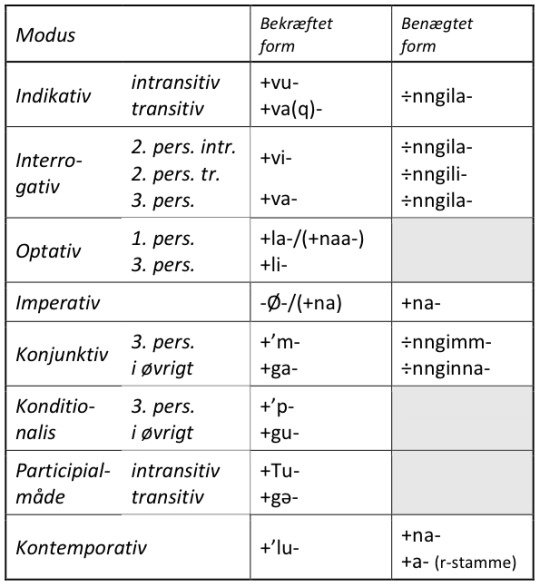
You already know the indicative.intransitive ending +vu- from sentences like “angivugut - we are big”, the negated form (benægtet form) “anginngilagut - we are not big” and the interrogative forms “angivugut? - are we big?”, “angivisi? - are you guys big?” and “angippat? - are they big?” (from the intermediate form angivvat > angippat), plus their negated forms.
How to build the transitive forms
What we will learn today are the endings for the indicative transitive mode, of which the basic ending is +va-.
As you’ve seen above, transitive verbs do not only agree with the subject (”S/he sleeps”.) but also with the object of the verb, which is unknown to English. There are two ways to explain which ending comes after +va- for which person constellation. The short story will regard the personal endings as monomorphemic for the sake of less confusion. So, when I’d say “I answer you.” the sentence would be “Akivakkit.” (akivoq means “S/he answers” and keep in mind that in most dictionaries verb entries are given with the 3. person singular by default, for intransitive verbs the verbal ending of an entry would be +voq and for transitive verbs it would be +vaa s/he-->him/her) The mode ending is +va-, as said above, and the ending that denotes that the verb’s meaning has I as the subject and you as the object (1Sg--X-->2Sg) is -kkit, so you add +vakkit to the verb stem aki- making akivakkit - I answer you. So, for every possible personal constellation, one ending would have to be learned, that would be 28 in total.
The long story would have to do with ergativity in Greenlandic, the agent of the verb takes the Ergative case and the object takes the Absolutive case. Ergativity means that the subject of an intransitive verb has the same case marker as the object of a transitive verb (unlike English, *Him sleeps vs. I see him), in this case, the object would have the markers you’ve already encountered in lesson 3. In fact, the endings for the personal constellations (I do XXX to you.) consist of two morphemes that underly so many extra rules that their true character is very often obscure. I will only illustrate this with the ending -kkit (I --> you, see above) which is built according to the following rules:
The first part after the mode ending +va- of those endings consists of the agent of the verb’s meaning in the Relative case, which would be -ma- in this case. When it is the subject of a transitive verb it gets reduced to -m-. In the next step, we take the second person singular in the absolutive case as the object ending, which would be -tit, and put it after the subject ending, but whenever the subject before it is either the first person singular or plural it becomes -git. This would leave us which: (+va)-m+git. As you may know by now, the consonants would assimilate to the last consonant, which would lead us to (+va)-ggit, but a double /gg/ becomes /kk/ when it is used with inflection (see gemination above), which eventually, makes the whole ending (+va)-kkit.
But as this is way too long for the basics in Greenlandic transitivity, it should suffice to learn the endings as one morpheme as an intermediate step, which would leave you with 28 endings for all the possible constellations within the indicative mode, instead of 47+ independent endings, that undergo more than 30 rules on how they change forms when they are combined depending on what comes before or after them.
In lesson 10, you’ve already learned some possessive endings, which are also used for whenever a person is doing a verb action to a third person singular or plural. In layman’s term, one can only possess grammatically third person(s). The only catch here: the endings are simpler and always the same (that’s a good catch, YAY).
Here is how the ending +va- changes according to the verb stem (s. lesson 3):
Vowel stem: aki- +va- > akiva- (to answer)
C-Stem: allap- +va- > allappa- (to write sth.)
R-Stem: atuar- +va- > atuarpa- (to read sth)
Object is the third person singular (3.Sg.) - thus: him, her, it
1.Sg. +ra, I > akivara > I answer him.
2.Sg. +t > You > allappat > You write it.
3.Sg. +a > S/he > atuarpaa > S/he reads it.
1.Pl. +rput > We > allapparput > We write it.
2.Pl. +rsi > Y’all > akivarsi > Y’all answer him.
3.Pl. +at > They > atuarpaat > They read it.
Object is the third person plural (3.Pl.) - thus: them
1.Sg. +kka, I > akivakka > I answer them.
2.Sg. +tit > You > allappatit > You write them.
3.Sg. +i > S/he > atuarpai > S/he reads them.
1.Pl. +vut > We > allappavut > We write them.
2.Pl. +si > Y’all > akivasi > Y’all answer them.
3.Pl. +it > They > atuarpaat > They read them. (A!-rule)
(As you see, there is no distinction between singular or plural third person object because the /i/ from the plural ending is assimilated to the preceding /a/.)
As mentioned in lesson 10, the similarity between the possessive endings and the endings to mark the object as a third person comes from a structure where the verb’s passive participle was, in fact, possessed: qimmeq > qimmera - my dog vs. akivara - lit. my answered thing (is) he > I answer him. That is the reason why, as I mentioned in the short story of the long explanation above, these endings are really monomorphemic, they only mark the possessor, in this case the subject/agent of the sentence.
Now, that we covered all constellations where any person does the verb’s action against/to a third person (sg. or pl.), I will show you what endings are used for the remaining constellations, e.g. you kiss me. Keep in mind, though, that reciprocal constellations like I--XXX-->myself/us are another cake that we will deal with later, they cannot be built this way.
That leaves us with the following constellations:
I-->you +kkit > akivakkit > I answer you.
I-->y’all +ssi > akivassi > I answer y’all.
We-->you +tsigit > akivatsigit > We answer you.
We-->y’all +ssi > akivassi > We answer y’all.
You-->me +rma > akivarma > You answer me.
You-->us +tsigut > akivatsigut > You answer us.
Y’all-->me +ssinga > akivassinga > Y’all answer me.
Y’all-->us +tsigut > akivatsigut > Y’all answer us.
S/he-->me +anga > akivaanga > S/he answers me.
S/he-->you +aatit > akivaatit > S/he answers you. **
S/he-->us +atigut > akivaatigut > S/he answers us.
S/he-->y’all +asi > akivaasi > S/he answers y’all.
They-->me +anga > akivaanga > They answer me.
They-->you +atsit > akivaatsit > They answer you. **
They-->us +atigut > akivaatigut > They answer us.
They-->y’all +asi > akivaasi > They answer y’all.
** These are the only endings in these last two paradigms where you can distinguish the number of the subject in the 3. person.
Whilst in English, almost the whole verbal paradigm has the same form, except for the third person singular (I/you/we/they sleep vs. S/he sleeps), there are fewer forms in Greenlandic that are ambiguous:
Akivaat. - They answer him or them.
Akivassi. - I or we answer y’all.
Akivatsigut. - You or Y’all answer us.
Akivaanga. - S/he or they answer me.
Akivaatigut. - S/he or they answer us.
Akivaasi. - S/he or they answer y’all.
Allappat - You write it. or They write? (see lesson 4 for questions)
In these cases, context is needed to make things clear, just as context is needed to know whether in the sentence “I see you.” means one or more persons that I see.
To come back the long story from above, can you spot the intransitive endings from lesson 3 at the end of the endings above?
Right:
Akivassi has -si as in intransitive Angivusi - Y’all are big.
Akivassinga has -nga as in intransitive Angivunga - I am big.
Akivatsigut has -gut as in intransitive Angivugut - We are big.
Akivaatit has -tit as in intransitive Angivutit - You are big.
As mentioned above, ergativity means to have the same case marker for the subject of an intransitive sentence Angivunga (I am big) and for the object of a transitive sentence Akivaanga (S/he answers me). This pattern can be seen here and is pretty different from English. We will deal with this pattern in the next lessons in more detail.
One last thing is, that Greenlandic is considered a pro-drop language, that means, that personal pronouns don’t have to be used because the verbal endings already make it very clear which persons are involved. Spanish, for example is also a pro-drop language, so, Te amo - I love you only expresses the object as a personal pronoun, not the subject, because the -o ending at the verb makes it clear enough that it is the first person singular. Greenlandic differs from this insofar as the object is also encoded in the verbal ending, so that also the object pronoun can be left out: Asavakkit - I love you.
The next lesson will be about how we use nouns with these verbs. Then, we will also have to deal with ergativity in more detail.
#Greenlandic#learn greenlandic#Kalaallisut#Kalaallit Nunaat#grønlandsk#grönländisch#gröönlännsch#lesson 12#linguistics#language learning#language#Eskimo#Inuit#Eskimo-Aleut#weak nouns#gemination#transitivity#ergativity#ergative#transitive
54 notes
·
View notes